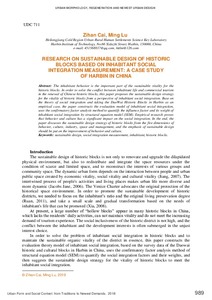RESEARCH ON SUSTAINABLE DESIGN OF HISTORIC BLOCKS BASED ON INHABITANT SOCIAL INTEGRATION MEASUREMENT: A CASE STUDY OF HARBIN IN CHINA
Скачать файл:
URI (для ссылок/цитирований):
https://elib.sfu-kras.ru/handle/2311/111777Автор:
Zihan, Cai
Ming, Lu
(Zihan, Cai, Ming, Lu.: Heilongjiang Cold Region Urban-Rural Human Settlements Science Key Laboratory Harbin Institute of Technology, No.66 Xidazhi Street, Harbin, 150000, China e-mail: 451568837@qq.com, hitlm@126.com)
Дата:
2019-05Proceedings of the XXV ISUF International Conference “Urban Form and Social Context: from Traditions to Newest Demands” (Krasnoyarsk, July 5–9, 2018)
Аннотация:
The inhabitant behavior is the important part of the sustainable vitality for the historic blocks. In order to solve the conflict between inhabitant life and commercial tourism in the renewal of Chinese historic blocks, this paper proposes the sustainable design strategy for the vitality of historic blocks from a perspective of inhabitant social integration. Base on the theory of social integration and taking the DaoWai Historic Blocks in Harbin as an empirical case, the paper constructs the evaluation model of inhabitant social integration, uses the confirmatory factor analysis method to quantify the influence factor and its weight of inhabitant social integration by structural equation model (SEM). Empirical research proves that behavior and culture has a significant impact on the social integration. In the end, the paper discusses the sustainable design strategy of historic blocks from the five dimensions of behavior, culture, industry, space and management, and the emphasis of sustainable design should be put on the improvement of behavior and culture.

